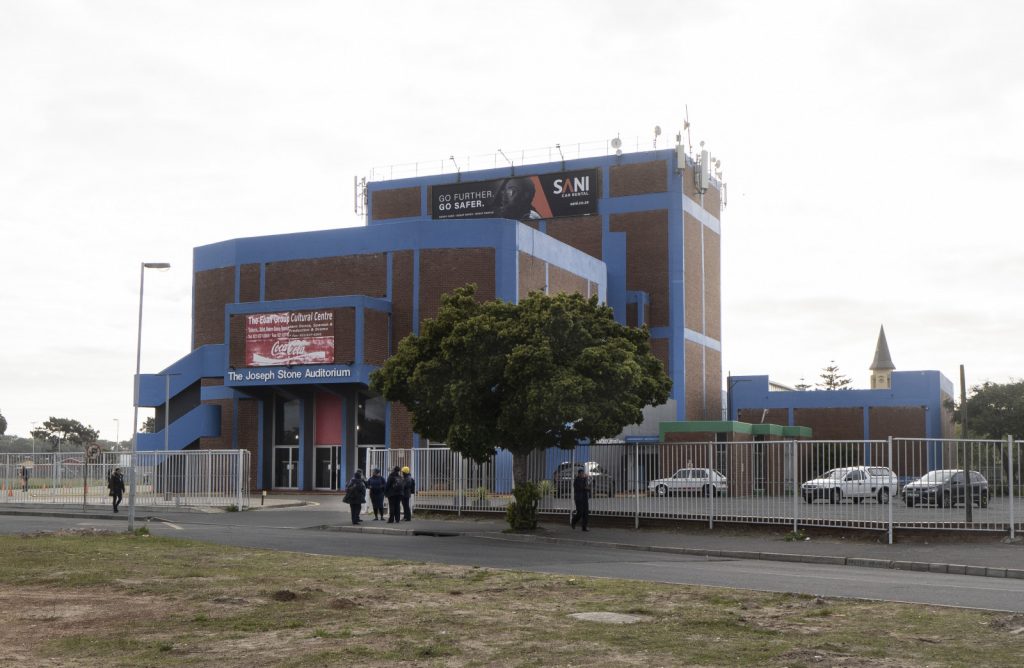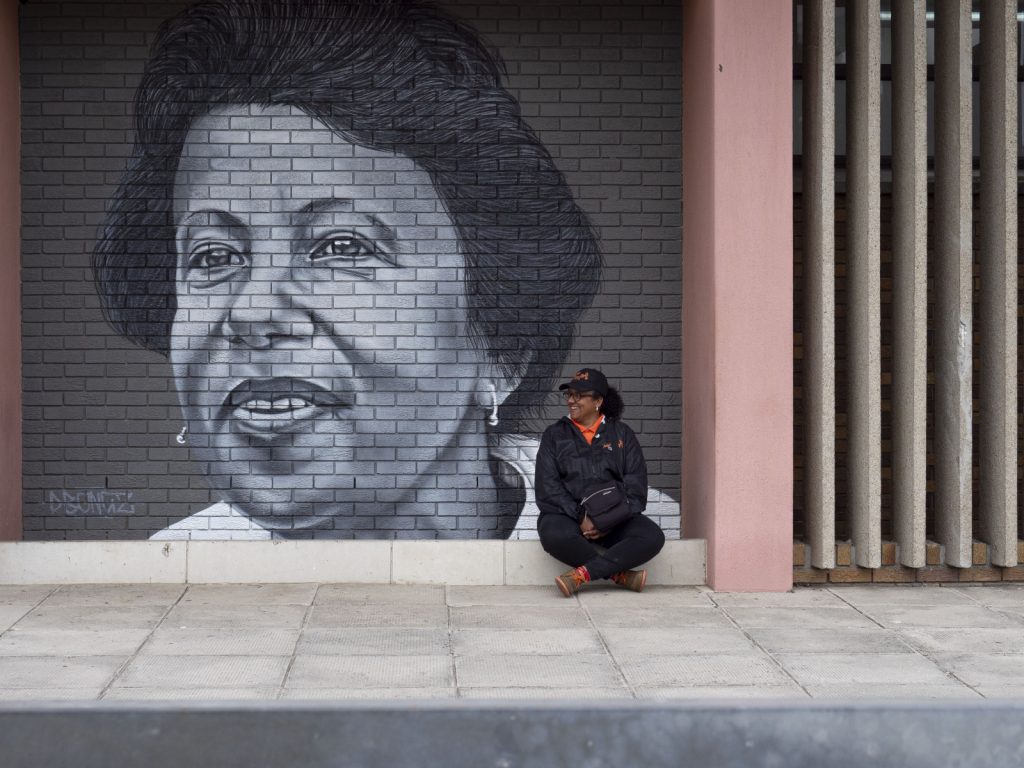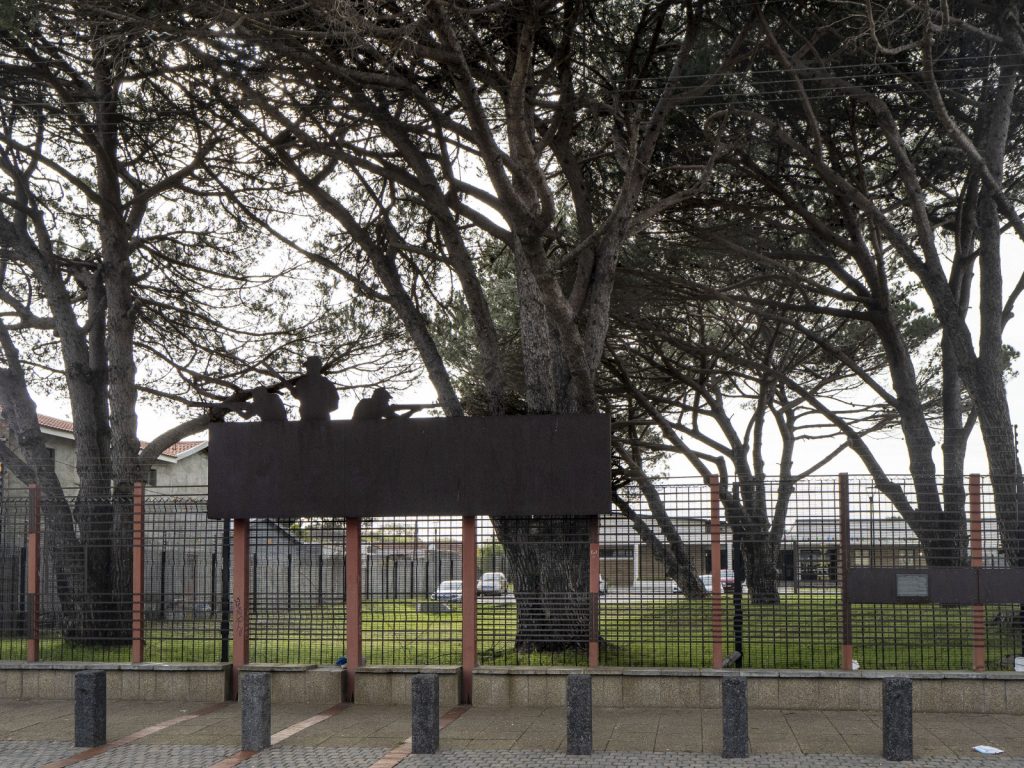A life-sized statue pays homage to Coline Williams and Robbie Waterwitch outside the Athlone Police Station Photo: Ryan Enslin
South Africa in 1968. Just two years prior the apartheid government had declared the Sixth Municipal District of Cape Town, aka District Six, a whites-only area.
Residents were forcibly removed to the Cape Flats, some 25km away. At that time, the Cape Flats were an expansive, low-lying area, a relatively barren and sandy place. Many of the roughly 60 000 residents affected were moved to the suburb of Athlone, which mushroomed at this time of untold heartache.
Fast forward to South Africa in 2022. Every day a further tragedy continues to play out in the lives of the people who call the Cape Flats, and in particular Athlone, home.
“Mixed-race residents, who were not white enough during apartheid, now found they were not black enough in the democratic era,” shares The Lady of Athlone. This is a title I have bestowed, in my mind, upon Anita Hermanus, as I drive into the suburb for another meeting with her. Some two months before we had spent time together exploring Athlone, but I just couldn’t get her out of my mind.
Anita, a qualified tour guide operating as Aunty Nita’s Tours, loves people almost as much as she loves history. She runs free walking tours in the CBD of Cape Town and the Bo-Kaap each weekday. But her true passion lies in the tours she developed around the Cape Flats, in particular her Athlone Tour — the Forgotten Heroes.
When I press Anita as to why Athlone, having grown up in nearby Grassy Park, she reminds me that the area was a hot spot of political resistance activity, especially during the 1980s. I secretly wrap myself over the knuckles for not knowing this, being a child of the 1980s myself. “I don’t recall a year during my schooling that we didn’t have some stay away or disruption. It’s just what we did in those days,” continues Anita.
She goes on to lament the fact that the Cape Flats, with its history of sadness wrought by displacement, doesn’t receive serious attention from local tourism bodies. “We are not part of the pretty Cape Town,” Anita says, a small grin enveloping her lips, “yet there are so many stories to be told here in Athlone.”
And this she sees as her mission — Anita’s Forgotten Heroes Tour shares fascinating tales of the courageous deeds of everyday people who stood up to an unjust and tyrannical system.
Joseph Stone Auditorium
The large triple-storey facebrick building along Klipfontein Road houses the Eoan group, today a performing arts collective. The group was founded in District Six in 1933 by Helen Southern-Holt, initially as an aftercare facility for young children.
Hailing from District Six, the children were found to be musically inclined. This led to the introduction of drama, elocution and ballet classes. The Eoan group thrived in this artistic outpouring and soon adults too were attending classes. The forced removals from District Six left the group without a home base, but a donation from philanthropist Joseph Stone saw the construction of an auditorium that today bears his name.
“Art and culture have always been a big part of our lives here on the Cape Flats, much of it coming from the Eoan group and the Joseph Stone Auditorium,” Anita shared with me, almost as a page from her diary.
 The Joseph Stone Auditorium stands proudly along Klipfontein Road in Athlone. Photo: Ryan Enslin.
The Joseph Stone Auditorium stands proudly along Klipfontein Road in Athlone. Photo: Ryan Enslin.
Dulcie September Hall
Directly across the road from the Joseph Stone Auditorium stands the Athlone Civic Centre, renamed the Dulcie September Hall. Born and educated in Athlone, September joined the ANC in 1976 and would go on to be appointed chairperson of the ANC Women’s League in London in 1979, followed by ANC representative to France, Switzerland and Luxembourg in 1983.
When Dulcie was assassinated in 1988 outside the ANC office in Paris, she had been investigating then-illegal sales of arms to the apartheid government in contravention of trade embargos. Today a mural of the heroine, undertaken by prolific street artist Dbongz Mahlathi, graces the front of the hall that proudly carries her name.
“It is sad that Dulcie is remembered and honoured more outside South Africa than in the country that birthed this brave soul,” points out Anita.
 Tour Guide Anita Hermanus at the old Athlone Civic Centre, now named the Dulcie September Hall with mural by Dbongz Mahlathi. Photo: Ryan Enslin.
Tour Guide Anita Hermanus at the old Athlone Civic Centre, now named the Dulcie September Hall with mural by Dbongz Mahlathi. Photo: Ryan Enslin.
Coline Williams and Robbie Waterwitch
Further down Klipfontein Road, opposite the Athlone Police Station, stand two bronzed life-sized figures in remembrance of the lives of Coline Williams and Robbie Waterwitch. These two Umkhonto weSizwe (MK) operatives were part of a scheme to plant five limpet mines to destabilise whites-only elections during 1989. Coline and Robbie were responsible for the Athlone placement as part of an anti-voter registration campaign across the Cape during July 1989.
The official story released by the apartheid government was that the limpet mine had detonated too early, but evidence heard at the Truth and Reconciliation Commission (1996 – 2003) offered up evidence that the limpet mine had indeed been tampered with. Presumably by a military operative who had infiltrated the MK branch.
A joint funeral was held for Coline and Robbie at St Mark’s Catholic Church in nearby Bonteheuwel. Closely monitored by police, the gathering had attracted upwards of 5 000 mourners and was eventually broken up using tear gas.
Anton Fransch and the Battle of Athlone
Born in nearby Bonteheuwel, Anton Fransch was instrumental in mobilising the youth during the 1980s state of emergency in South Africa. At age 17, Anton was featured on the television program Police File as a fugitive and terrorist, having left the country in 1986 to receive specialist military training in Angola.
Anton secretly returned to South Africa in 1989 with a brief to establish new military cells in the now-Western Cape. Using the alias David Govender, a university student, he rented a room in an Athlone home on Church Street. After the police captured a friend, his location was given up. At midnight on 17 November 1989, the security forces surrounded the house and a seven-hour battle ensued, but not before Anton was able to move his host family to safety.
Incredibly, Anton held off the onslaught of more than 40 policemen with just one pistol, an AK-47 assault rifle and a few explosives. Eventually, a hand grenade thrown into the property would kill him, with the security forces claiming he had committed suicide before the grenade was deployed.
Standing on Church Street, outside this now infamous double-storey house, the Battle of Athlone plays out in my head. And my heart breaks for our country, a silent ode to the idiocy of an inhumane system that would wreak this level of horror on its own citizens.
Trojan Horse Memorial
Probably the most chilling part of the tour to me, was the Trojan Horse Memorial on Thornton Road. This section of Athlone was commonly used as a meeting point for politically aware scholars, owing to the number of schools along the road. On 15 October 1985, an orange flatbed truck, supposedly stacked with crates, drove up and down Thornton Road during protest action.
At one point stones were thrown by protestors at the truck, which triggered the authorities. Several armed policemen jumped up from inside the crates and opened fire on the crowd, killing three youths and injuring 12 more. Jonathan Claasen, 21, Shaun Magmoed, 15, and Michael Miranda, 11, lost their lives that day.
But what the police didn’t count on was that a CBS News crew had recorded the shocking events. The footage was smuggled out of the country and broadcast around the world, bringing increased pressure to bear on the apartheid government and encouraging further support from internationals for the call to end apartheid.
“Sadly the same tactic was employed a short while later in the nearby township of Gugulethu, where two people were killed while playing soccer,” shared Anita with me.
 The Trojan Horse Memorial onThornton Road in Athlone pays tribute to the three youths who lost their lives in 1985. Phone: Ryan Enslin.
The Trojan Horse Memorial onThornton Road in Athlone pays tribute to the three youths who lost their lives in 1985. Phone: Ryan Enslin.
The Athlone stories continue
Anita has many more stops to share on her tour, for those eager to listen. Like Super Fisheries where the Gatsby originated from, the lesser known home of operative Ashley Kriel and his story, Athlone’s connection to Taliep Petersen and the history of the Wembley Roadhouse. When you find yourself on one of Aunty Nita’s Tours, be sure to get your #onsie, Anita’s version of a #selfie.
Safety in the Cape Flats is often a cause for concern, but Anita maintains strong links to the community in which her tours are based. When gang violence is an issue, the word is communicated to the Lady of Athlone and tours are rescheduled.
When tourism educates, we all win, and this sector is so vital to our struggling economy. Fortunately, there are champions like Anita, putting their rubber to the road. “It’s not about Aunty Nita’s Tours,” she boldly stated as we were about to part ways. “It’s about educating people through sharing the stories of Athlone.”
For more on Aunty Nita’s Tours contact Anita at +27 82 572 7377 or
www. auntynitas.co.za